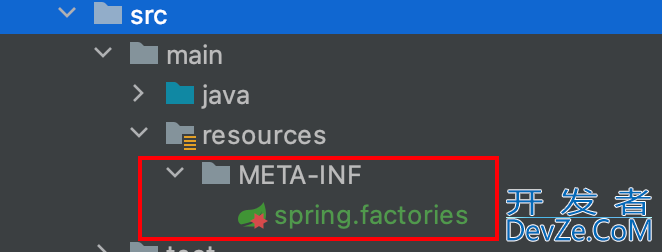SpringBoot中的自定义starter
目录
- 自定义starter
- 1、首先创建一个普通的 Maven 项目
- 2、创建一个配置类
- 3、创建一个服务类 HelloService
- 4、自定义自动配置类
- 5、创建 spring.factories 文件
自定义starter
所谓的 starter ,其实就是一个普通的 Maven 项目。
1、首先创建一个普通的 Maven 项目
引入自动化配置依赖:
<dependency>
<groupId>org.springframework.boot</groupId>
<artifactId>spring-boot-autoconfigure</artifactId>
<version>2.1.8.RELEASE</version>
<!-- 表明不传递spring-boot-autoconfigure依赖 -->
<optional>true</optional>
</dependency>
注意:在自定义的starandroidtjgdmfOOgJer 的pom中,将spring-boot-autoconfigure的maven依赖声明为<optional>true</optional>,表明自定义的starter的jar包不会传递spring-boot-autoconfigure依赖;否则会将spring-boot-autoconfigure版本固定,导致引用自定义starter的应用出现版本冲突问题。
starter命名模式 --> ${module}-spring-boot-starter;
例如:
<groupId>com.hello</groupId> <artifactId>helloService-spring-boot-starter</artifactId> <version>0.0.1-SNAPSHOT</version>
2、创建一个配置类
创建一个配置类 HelloProperties 来接受 application.properties 中注入的值:
@ConfigurationProperties(prefix = "Javaboy")
public class HelloProperties {
privatestaticfinal String DEFAULT_NAME = "默认名";
privatestaticfinal String DEFAULT_MSGjs = "默认消息";
private String name = DEFAULT_NAME;
private String msg = DEFAULT_MSG;
public String getName() {
return name;
}
public void setName(String name) {
this.name = name;
}
public String getMsg() {
return msg;
}
public void setMsg(String msg) {
this.msg = msg;
}
}
3、创建一个服务类 HelloService
public class HelloService {
private String msg;
private String name;
public String sayHello() {
return name + " say " + msg + " !";
}
public String getMsg() {
returnphp msg;
}
public void setMsg(String msg) {
this.msg = msg;
}
public String getName() {
return name;
}
public void setName(String name) {
this.name = name;
}
}
4、自定义自动配置类
SpringBoot自动装配的命名规则:
- 自动装配类应命名为:XxxAutoConfiguration;
- 自动装配package命名模式: ${root-package}.autoconfigure.${module-package},比如:
org.springframework.boot.autoconfigure.aop.AopAutoConfiguration
@Configuration
@EnableConfigurationProperties(HelloProperties.class)
@ConditionalOnClass(HelloService.class)
public class HelloServiceAutoConfiguration {
@Autowired
HelloProperties helloProperties;
@Bean
HelloService helloService() {
HelloService helloService = new HelloService();
helloService.setName(helloProperties.getName());
helloService.setMsg(helloProperties.getMsg());
return helloService;
}
}
注解 @EnableConfigurationProperties 使我们之前配置的 @ConfigurationProperties 生效,让配置的属性注入到 Bean 中。
注解 @ConditionalOnClass 表示当项目的 classpath 下存在 HelloService 时,后面的配置才生效。
5、创建 spring.factories 文件
在resources目录下新建 META-INF/spring.factories 文件:
org.springframework.boot.autoconfigure.EnableAutoConfiguration = \ com.hello.autoconfigure.HelloServiceAutoConfiguration

这里的key是固定的,value是我们的自动配置类的全路径。
SpringBoot 项目启动时,会做自动配置,会去扫描所有jar包中的 META-INF/spring.factories 配置文件。
至此,自定义的starter已完成。将这个自动化配置类的项目安装到maven仓库中,然后在其他项目中引入依赖就js可以使用。
新建一个普通的 Spring Boot 工程,并加入我们自定义的 starter 的依赖:
<dependency> <groupId>com.hello</groupId> <artifactId>helloService-spring-boot-starter</artifactId> <version>0.0.1-SNAPSHOT</version> </dependency>
此时我们项目中已有一个 helloService 实例可以使用,而且我们还可以配置它的属性数据,例如,在 application.properties 中配置:
javaboy.name=我的名字 javaboy.msg=提示消息
我们做个单元测试:
@RunWith(SpringRunner.class)
@SpringBootTest
public class MystarterApplicationTest {
@Autowired
private HelloService helloService;
@Test
public void contextLoads() {
System.out.println(helloService.sayHello());
}
}
控制台会打印:
我的名字 say 提示消息 !
到此这篇关于SpringBoot中的自定义starter的文章就介绍到这了,更多相关自定义starter内容请搜索编程客栈(www.devze.com)以前的文章或继续浏览下面的相关文章希望大家以后多多支持编程客栈(www.devze.com)!







 加载中,请稍侯......
加载中,请稍侯......
精彩评论